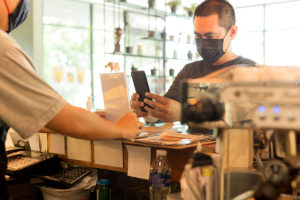Four Easy Steps to a Great Holiday Shopping Season
This has been a year to forget for almost everyone, but it has been especially hard on people in retail and customer service. Coronavirus, social unrest and natural disasters have combined to keep people isolated, socially distanced, unemployed, or just hiding out for nearly the entire year. And now, with the holidays on the horizon, what’s an independent retailer to do to salvage the year? There are some steps you can take to make sure your holiday shopping season brightens your outlook and your bottom line.
The outlook is not good for the traditional holiday shopping season with some surveys finding that more than half of Americans planning to sit out Black Friday in 2020. Thanks to the coronavirus, the trend toward online shopping that began 20 years ago took a huge leap forward and now close to half (47%) of American consumers plan to do their holiday shopping online.
Sadly, a PayPal commissioned survey, shows that 20% of small and mid-sized businesses say their future is dependent on how well they do this holiday shopping season.
Fear of coronavirus is the reason most shoppers are choosing to avoid the stores this year, but with the proper precautions and planning, independent stores can still lure in holiday shoppers during Black Friday, Small Business Saturday, and the season-capping Super Saturday.
Reduce the Obstacles
In the age of social distancing, most customers have demonstrated a desire for a safe and secure shopping environment. So, it’s probably not a good idea to stuff your aisles with door-buster products and massive endcap displays. Just like a good municipal traffic planner, the best plan to make customers feel safe is to focus on the flow of shoppers through your store.
Jack Kleinhenz, chief economist for the National Retail Federation, offers some simple suggestions to businesses that could help increase customer trust and improve store foot traffic during the upcoming COVID-19 holidays. Among them are:
Create customer flow.
Creating a customer-friendly traffic flow in your store will make shoppers more at ease and willing to linger. As a condition for reopening following the pandemic shutdown, many states and municipalities limit the number of shoppers allowed in stores. A good traffic pattern helps consumers shop more efficiently thereby reducing time spent in the store and increase a store’s footfall.
Grow your sales floor.
It won’t work for everybody but moving some of your items into a parking lot, a closed street, a side yard, or onto a deck can increase your sale space and decrease your customer density. If your space and the weather permits, customers might enjoy the opportunity to shop al fresco.
Self-Service Anyone?
With more and more shoppers opting to shop online to avoid public places or contact, programs like buy online, pick up in-store (BOPIS) and local delivery are booming. According to Adobe Analytics data, BOPIS orders increased 208% for the period of April 1-20 compared with the same time in 2019. Big box stores were among the first and most fervent adopters of the programs with Walmart, Home Depot, Best Buy, and Dick’s Sporting Goods all using the concept.
Self-checkout registers, store associates armed with mobile checkout devices, or kiosks are technologies stores are implementing to entice customers back into their stores.
“One of the things that is going to be very important is that the consumer is going to have to feel it’s safe to go into that store. We’re going to have to recognize that the environment has changed,” says Barbara Kahn, professor of marketing at the University of Pennsylvania’s Wharton School. “But as people get used to that environment, they may start to gravitate towards these physical stores. I think people are craving social interaction. They want to get out there. They don’t like the sameness of sitting at home looking at their computer screens. They really want to interact. So if the stores can respond and respond quickly enough, I think as we slowly get used to this new environment, we can start to increase consumer confidence as they feel safe and they feel better about the outside environment.”
Increasing consumer confidence includes adopting low- or no-contact retail technology such as in-aisle checkout on mobile devices, contactless payment terminals, and programs like BOPIS and delivery options.
 Adjust Your Inventory
Adjust Your Inventory
The holidays are a traditionally heavy online-shopping season. Last year, 78% of U.S. holiday shoppers used three or more channels to do their holiday shopping and 58% of shopper-reported purchases were made online. This year, those numbers are expected to grow with almost 75% of U.S. shoppers planning to shop online more for the holidays than they did in previous seasons.
People will be buying items with social distancing and self-quarantining in mind. Health-related products such as stationary bikes and workout equipment, home entertainment, remote-learning tools, and DIY home improvement tools and materials have all seen an uptick in sales over the past six months. The combination of a rise in DIY home projects and the closure of many American wood mills has created a lumber shortage that’s affecting the home building industry.
Sales including pet supplies, home office items, board games, hobbies and crafts supplies also grew when people began spending most of their work and spare time at home.
Gift cards are also expected to be big sellers this holiday shopping season. They require less contact to procure and assure the recipient receives a gift they want which results in fewer or no returns. It’s a good idea to stock up this year.
Eliminating what isn’t selling and stocking up on what is can assure you have less left-over stock in January.
All Hands On Deck
Even though most pundits are predicting a slower-than-normal holiday shopping season, that doesn’t mean stores can get by with fewer employees. Thanks to the coronavirus, more hands will be needed – gloved of course – for customer service, remote checkout, curbside pickup, and delivery services.
Both Walmart and Target announced increased hiring for the holidays with a focus on order fulfillment and pick up. Walmart is hiring 20,000 seasonal workers, the first time in five years the company has announced significant holiday hiring. Target is doubling its Drive Up and Order Pickup staffing nationwide. Depending on the size of your staff, it might be a good idea to dedicate people to online order fulfillment and curbside pickup.
With shoppers unable to try out products, or try on clothing, and more getting gifts shipped, be ready for more returns, too.
Despite the social and economic upheaval, most retail and economic experts expect Americans to find ways to celebrate with both gift-giving and socializing.
“There’s always room somehow to find [the budget] for either Christmas or Hanukkah or for the holidays. But it will be a challenging one,” Kleinhenz says.
 Promising Developments
Promising Developments
There are some positive developments from the pandemic for the retail industry.
The technology being adopted to deal with social distancing and low contact guidelines often simplifies the processes of doing business. Omnichannel retail – linking all sales and marketing channels and business management processes – done properly gives businesses a single touchpoint to review and manage all its operations.
People are investing more in their health and homes. Because the pandemic pushed so many people to work from home, they are working to improve their homes. Home offices, gyms and entertainment centers are among the most popular investments for homeowners. It has been a boon to the DIY and hardware, health and fitness, and home entertainment industries.
Shopping locally has been trending for years and has gotten a boost from the pandemic. With supplies to some essential products limited, many consumers have looked to independent, local businesses to fulfill their needs. Socially conscious consumers are also choosing to shop at local stores to contribute to the health of their community during economic struggles.
Because of the uncertainty of the supply chain, people are looking to new stores and brands to get their goods. A McKinsey & Company report shows an incredible 75% of consumers are trying new avenues, 36% trying new brands or products, and 33% trying new retailers, stores or websites.
All this means Black Friday, Small Business Saturday, and the weeks leading up to Super Saturday can help turn a bleak year into a good one. While it won’t be a record-setting holiday shopping season, if approached correctly it can be a happy holiday for independent retailers.
brian bullock
Author


